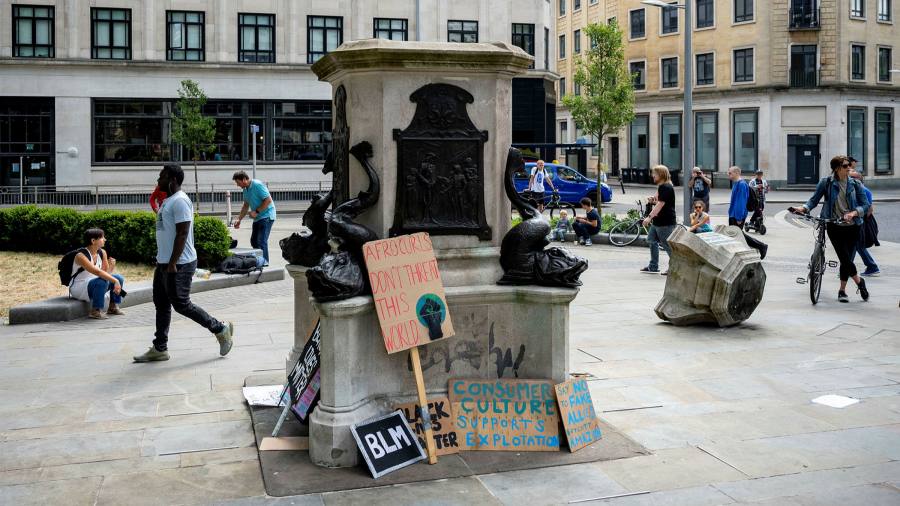[ad_1]
The writer is an award-winning science journalist and the author of ‘Superior: The Return of Race Science’
Ministers’ fears that activists could try to airbrush British history have led the UK government to summon the heads of national museums and other heritage bodies to ask how they will follow through on its new policy of “retaining and explaining†contested public monuments. The summit this week, called by the Department for Digital, Culture, Media and Sport, follows the toppling of a statue of slave trader Edward Colston in Bristol in June.
Scientific history isn’t exempt from government attention. As scholars know, archaeology, anthropology and the natural sciences have always been plagued by prejudice, affecting how people and artefacts have been presented. But critics worry that, as these histories are acknowledged, even great figures such as Charles Darwin might be knocked off their pedestals for their racist and sexist beliefs.
Last year, I joined a steering group at London’s Natural History Museum charged with reviewing naming and representation. It’s an issue all institutions are reckoning with. Last month, the British Science Association renamed its Huxley Summit for thought leaders to “For Thoughtâ€, over concerns about 19th-century biologist Thomas Huxley’s role in scientific racism, which fed the dangerous ideology of eugenics. As more cases like this come up, museums justifiably wonder whether they could be fairer to the facts and broader with their narratives.
The government’s view is that, rather than removing offensive memorials, they should be put into context. In 2019, I saw for myself just how difficult that is for a national museum. Since 1940, the American Museum of Natural History in New York has had an imposing statue of Theodore Roosevelt, former president and nature lover, on its steps. He sits high on a horse, flanked below by an unnamed African man and an unnamed indigenous American man. The hierarchy is obvious. To answer this problem, the museum’s curators have put up an exhibition indoors explaining the trouble with the statue, including — vitally — reactions from the public.
But it was easy to miss. The statue, meanwhile, was unavoidable. You could see it from across the street. Last summer, the museum asked for it to be taken down altogether, with support from Roosevelt’s great-grandson.
If this sounds like politics forcing hands, don’t forget the politics embedded in the statue to begin with. History isn’t written once. It’s written afresh by every generation, not because the facts necessarily change, but because our perspectives do.
Think of the way we now regard Alan Turing. In 2019, 65 years after his death, the New York Times published an obituary for the computer scientist and second world war codebreaker. What took them so long? It wasn’t only because his achievements were classified when he died, but because even in the decades after they were known, his homosexuality — for which he was convicted — meant people were unwilling to celebrate him.
In 2009, the UK government apologised. Turing has taken his place in British scientific history. Changing social attitudes rewrote the past and helped Britain confront its mistake. Scientific history is still being updated with hidden figures, particularly women and those from minorities.
“We cannot — and should not — now try to edit or censor our past,†communities secretary Robert Jenrick said last month. But censorship is already woven into the way the past was written. Without understanding how certain people and ideas were erased, and others were deliberately promoted, we’re left with distorted narratives.
Besides which, it’s hard to maintain these fictions in our social media age, when visitors need only go online for five minutes to know that some of the people glorified as scientific or philanthropic heroes in our museums were racists, eugenicists, benefited from the slave trade or held some other bigotry.
Perhaps a better way of showcasing scientific history is to see science for what it is — a slow, collective struggle towards universal truths, bitterly debated by scholars, making mistakes as they go until more information comes along, and inevitably affected by politics. Presenting research in this way might also help the public make sense of why, for instance, some health experts this last year have disagreed over treatment for Covid-19 or mask-wearing.
Darwin is at no risk of being cancelled, of course. But we would do well to reconsider where scientific history starts. Maybe it should never have been with busts and statues, but with the debates and tensions between scientists and the wider world in their time.
Â
[ad_2]
Source link






